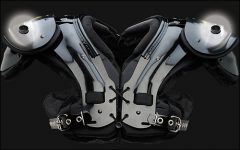
NFL uses football with built-in RFID tags
[ad_1]
The NFL League Committee has recently begun to evaluate the effects of UWB RFID tags embedded in football. The committee’s goal is to analyze the league’s effectiveness in obtaining preseason rugby positions and their movement visibility.
Matt Swensson, VP of NFL Emerging Products and Technology, said that the project is the next step of the NFL’s Next Gen Stats initiative, which aims to use the technology to provide broadcasters and fans with more information about the game and player performance.

(Since 2014, the NFL began to embed Zebra’s UWB RFID tags in the plastic layer of the player’s shoulder pads)
Since 2014, the NFL League began to embed Zebra’s UWB RFID tags in the plastic layer of the player’s shoulder pads. These battery-powered tags can provide fans and media with athletes and their performance data. This information has been manually detected and recorded in the past.
At present, the league has provided these data to the media so that they can provide audiences with more game analysis data. In addition, Xbox One users can also access Microsoft’s NFL application to view the three-dimensional map of the stadium, as well as the player location information. The NFL’s Next Gen Stats website this season also displays more information based on these data.
Swensson said that the NFL plans to use UWB RFID tags on footballs on all Thursday games this season, but does not intend to announce it to the public. He said: “These data will help analyze high-level data such as frequent toss and capture of the ball, ball speed and other high-level data.”
Currently, all NFL players have worn shoulder pads with built-in tags. In addition, 31 stadiums and several international stadiums each have installed 20 to 25 Zebra UWB receivers to capture tag signals and transmit them to Zebra’s MotionWorks software. Eric Petrosinelli, Zebra’s general manager, said the system uses triangulation to determine the player’s position and movement.
This summer, Zebra, the NFL League, and rugby provider Wilson have teamed up to embed a customized version of the Zebra UWB tag in each ball. Petrosinelli stated that the label is the same size as a cent coin. The weight of each shoulder pad label is 8 grams, and the weight of the rugby label is less than 4 grams. These tags don’t have much impact on the players at all.
Each UWB tag of a football will transmit multiple signals in the 6.35GHz and 6.75GHz frequency bands per second. A reader installed on the court can read these signals within a range of 325 feet. The battery life of the built-in tag can be at least one season.
Petrosinelli said: “This is the third year of our cooperation with the NFL. This also means that the NFL stadium has used Zebra receivers for 2 years. Most of the equipment is installed behind the LED tubes and on the higher positions of the stadium for Read the tag signal.”
Petrosinelli stated that the Zebra solution provided visual information about the game. Although the NFL has obtained visibility information on player movements, football is always the most important item in the game. The game tracking program allows the league to know the rugby position information of each player at each moment. For example, if the player accelerates while the ball is in the air, the NFL can eliminate the cause of acceleration.
Swensson said the NFL is still exploring the possibility of using these tags to determine football movement. The league hopes to judge whether the rules can be changed based on these data to make the game more exciting.
[ad_2]



